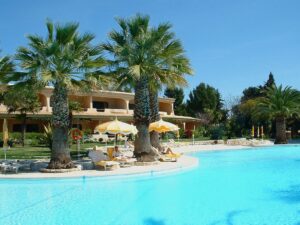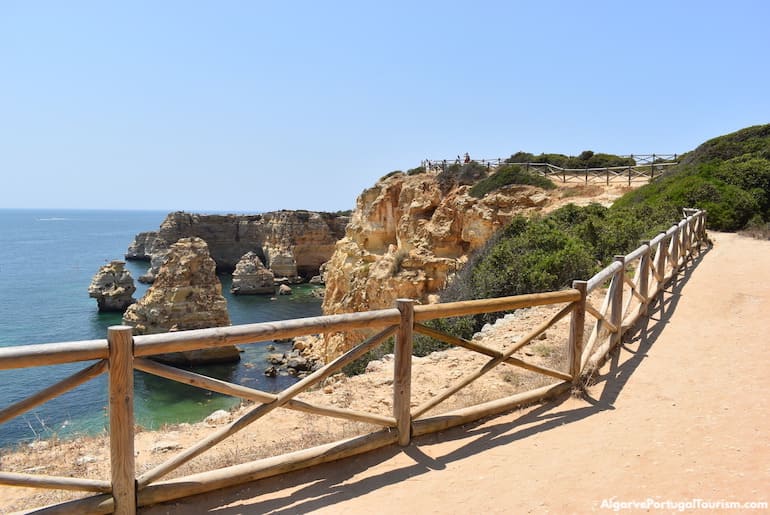
There are several wonderful walking trails in the Algarve, but the Seven Hanging Valleys Trail is the one that even those who don’t usually hike will want to experience. It offers stunning views and goes through some of the most beautiful beaches in Europe. It’s considered one of the best hikes on the continent, and when you see and experience it for yourself, you’ll surely agree. But make sure your phone or camera is fully charged, as you’ll be taking countless photos.
The name of the trail derives from the eroded valley that was sliced by seven streams over the years. Displays spread along the coast explain the natural features, the fauna and the flora.
This trail climbs up and down ravines that almost always open up above sea level – the hanging valleys. In the distant past, each hanging valley was associated with the mouth of a stream and was created by a rapid retreat of the coastline which was not accompanied by the water’s edge.
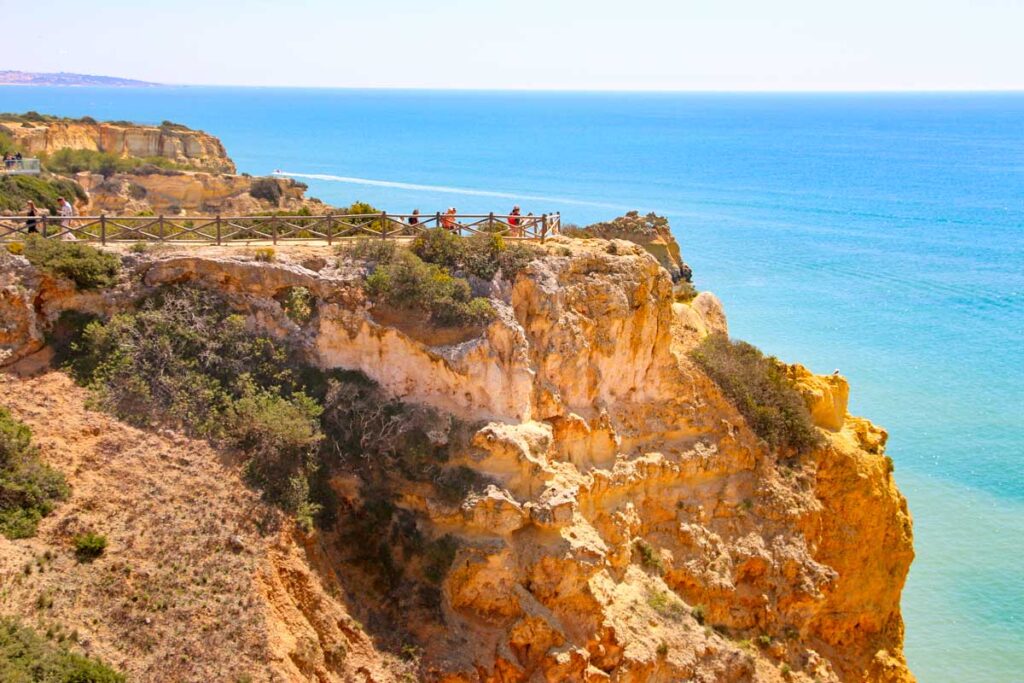
Stunning views, coves, geology, and sunsets. The Seven Hanging Valleys Trail is not to be missed! It is easy to get excited about this gorgeous trail that guides you through some of the most striking natural gems in the Algarve.
Elected as one of the very best hikes in Europe by European Best Destinations, this scenic route runs from Praia da Marinha in the east to Praia de Vale Centeanes in the west.
This is a relatively easy trail, just not recommended for the elderly, young children, or those with mobility issues. It covers a total of 5.7 kilometers (3.5 miles), but as most people go and return to the starting point, they end up walking double that. Depending on how many stops you make, the entire walk can take over two hours (over four hours to go and return). Many people stop to rest and relax at the beaches for a while, so this often ends up being an all-day activity. There’s a picnic area to the east of the Alfanzina lighthouse, which stands between Praia do Carvalho and Praia de Vale Centeanes. If you’re not a keen walker, consider going just between Praia da Marinha and Praia de Benagil.
Most people start at Praia da Marinha, which everyone will tell you is Algarve’s must-see beach. From there, the trail continues over the cliffs to the west, over other beaches of the Lagoa district (Praia de Benagil and Praia do Carvalho), and ends at Praia de Vale Centeanes. At Benagil, it’s possible to hop on a boat to the famous Benagil Cave and tour the spectacular coast of hidden grottoes and tall sea stacks sculpted by the forces of nature over thousands of years.
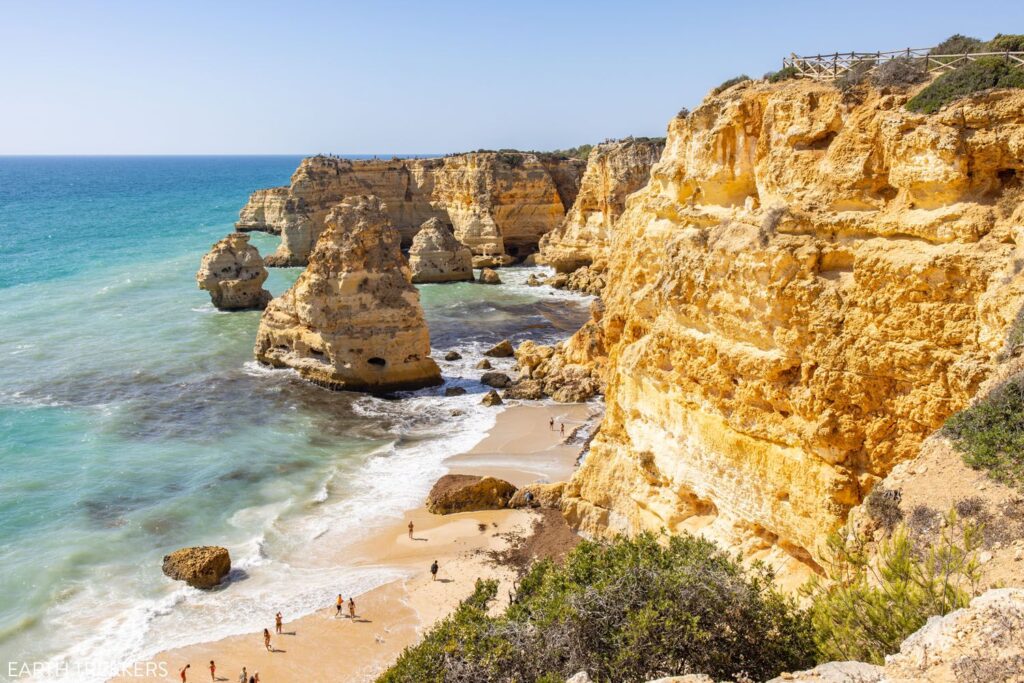
Always wear light clothing, comfortable footwear, a hat and sunglasses, and use enough sunscreen. Also don’t forget to take plenty of water and a few snacks, and don’t leave any trash on the ground! The trail is rather safe, but you should always keep some distance from the edge of the cliffs (some parts are fenced for safety). In case of any emergency, dial 112.
Beaches by Seven Hanging Valleys Trail
There are four beaches on the Seven Hanging Valleys trail, accessed from the top of the cliffs, and there are others only accessible by boat). They are:
Praia da Marinha
It’s one of the top beaches in the Algarve and the one everyone will tell you is a must-visit. Even if you don’t stay sunbathing, you’ll surely spend quite some time admiring the spectacular rock formations from the top of the cliffs.
Praia da Marinha is widely considered one of the most beautiful beaches in Europe as well. The sweeping view over this beach reveals an array of outstanding landforms such as grottoes, stony arches, natural bridges, and precarious sea stacks where seabirds nest and rest.
At the bottom of the cliffs, a contrasting palette of azure and yellow is formed between the shallow waters over the gently sloping sand and the sprinkling of rocks that attract sea life and a few happy snorkelers. Seagulls and cormorants crisscross the blue atmosphere above, before landing accurately on the vertical rocky walls.
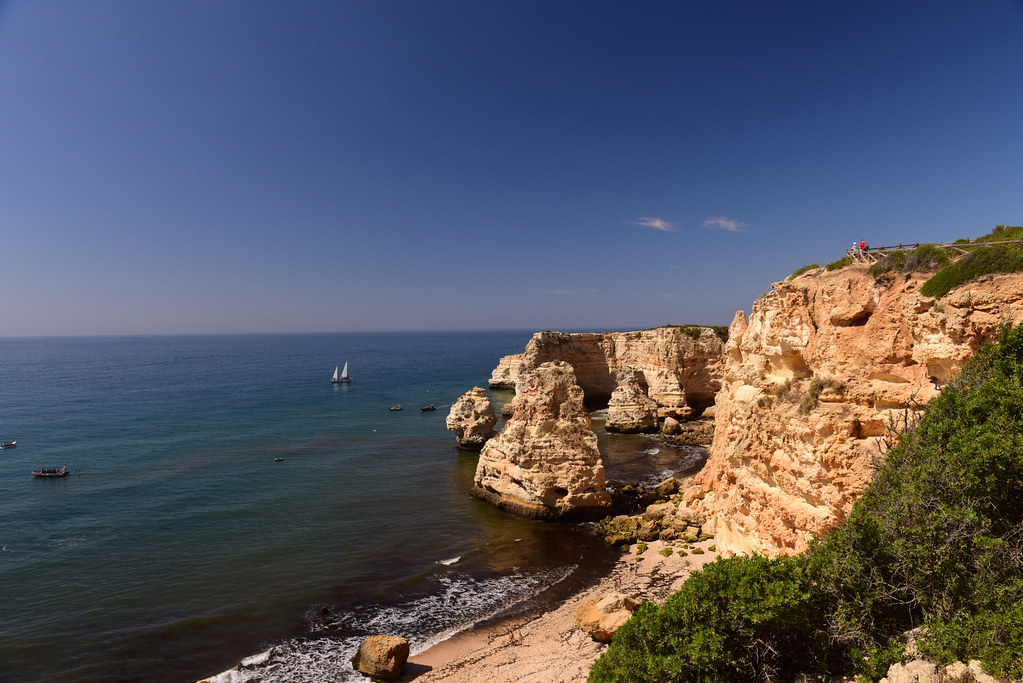
Praia do Carvalho
To reach this beach, you have to find a tunnel dug on the ground. It has a fairy tale atmosphere, not just for the “secret” passage, but also for the “window” open on a cliff that frames a picture-perfect view, with a rock perfectly centered in the water.
At Praia do Carvalho, you can reach the beach through a tunnel excavated in the soft Miocene limestones, where you can see a profusion of sea shells aggregated in the rocky groundmass. Among the Mediterranean coastal scrubland, there is the Mediterranean dwarf palm, the only European palm tree, and you can see the Sardinian warbler, a small bird typical of the region.

Praia de Bengail
It’s not a very big beach, and it wouldn’t be as popular as it is if it wasn’t the main access to the must-see Benagil Cave. This is considered one of the most extraordinary sea caves in the world, and if you can’t make it there by boat, you can always peek inside it from above, through an opening found on the trail at the top of the cliff.
Praia de Benagil is associated with the mouth of a pluvial stream that carved a narrow gully in the cliff. This beach has sheltered a fishing community dedicated to traditional crafts; nowadays, vessels are mainly busy with visits to the marine caves.
At Benagil, visitors can jump aboard one of the skiffs offering trips to these spectacular sinkholes and sea caves. Such trips usually make several stopovers, including at the large, light-filled dome of the famous Benagil Cave.
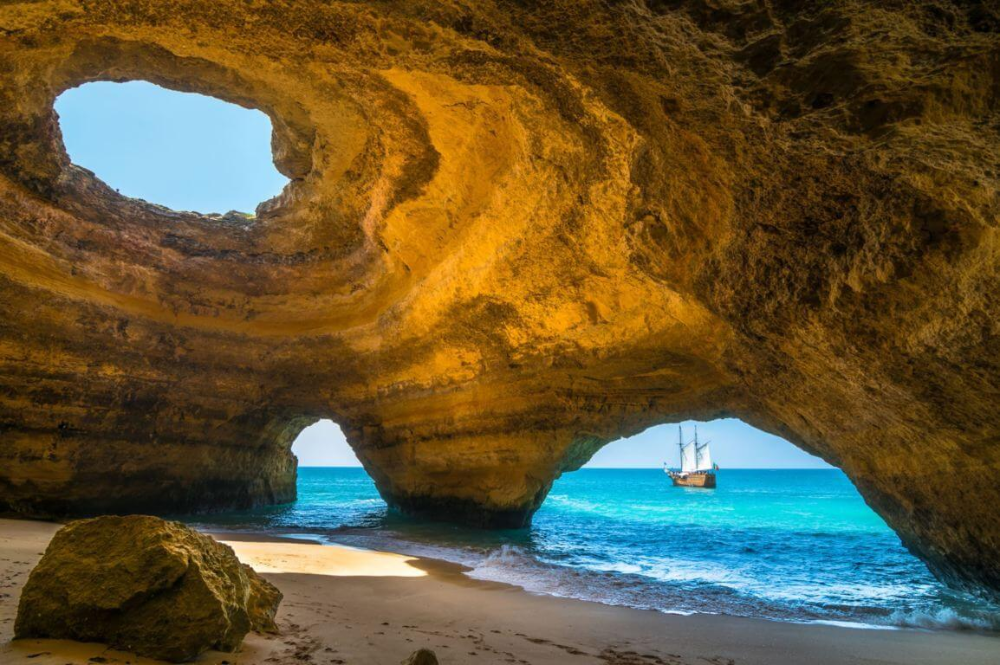
Praia de Vale Centeanes
Boats also depart from this beach to the Benagil Cave. It’s close to the town of Carvoeiro, so it’s where many tourists start their hike through the Seven Hanging Valleys, instead of in Praia da Marinha. Unlike many other beaches in the area, it has a restaurant, perfect to recover some calories at the end of the hike.
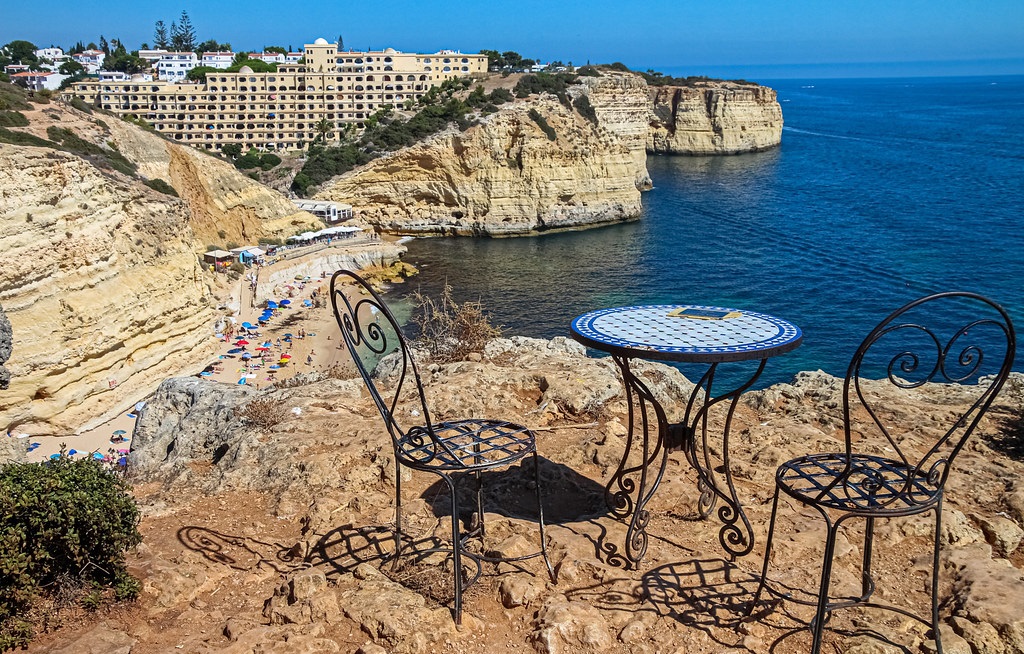
After the deep green of Mediterranean vegetation comes a lunar landscape of naked, bare rock. Old legends are told about this great boulder, the Leixão do Ladrão, such as that of the Moorish princess who mourns the death of her lover, her tears create the paths and tracery so typical of limestone.
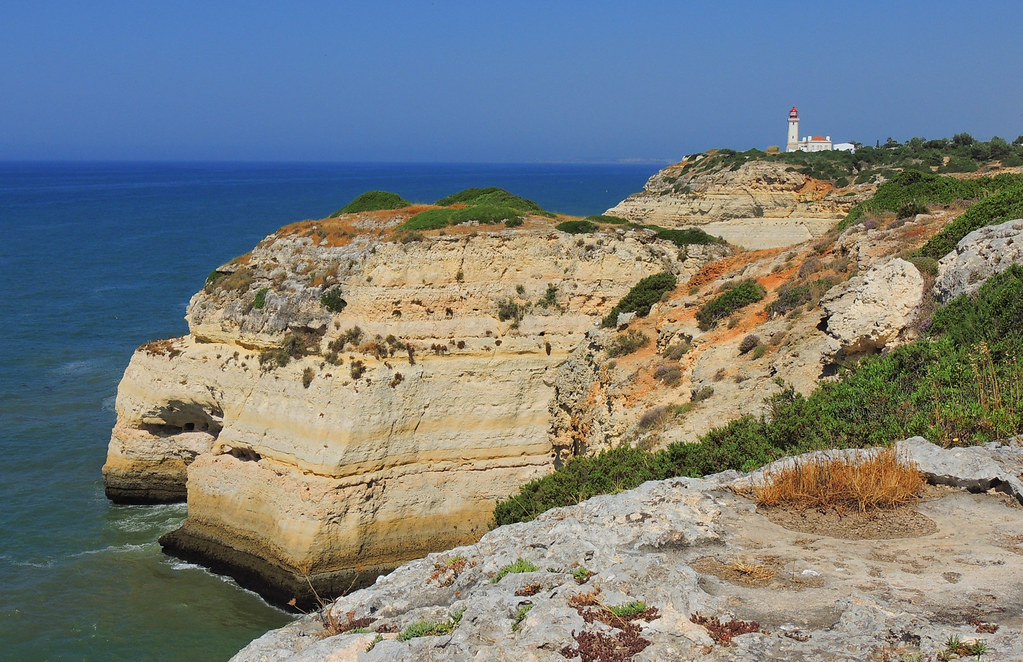
Near the Alfanzina Lighthouse grows a grove of Aleppo pine, one of the few trees that managed to settle in this rocky and arid terrain. Here, the pine forests function as ecological islands for tits, rock-thrushes, or little owls. Dense vegetation favors mammals such as the rabbit, the Egyptian mongoose, or the fox.

How to get to the Seven Hanging Valleys Trail
The Seven Hanging Valleys is in the Lagoa district, which is best to be reached by car.
Trains from Faro and other major towns in the Algarve stop at the Estômbar-Lagoa station, which is outside the center of town and away from the coast.
The Vamus bus is therefore the only reasonable public transportation option. Number 52, operated by Vamus between May 1st and October 31st, runs six times a day (every 2 hours) between the towns of Alvor and Armação de Pêra, stopping at Praia da Rocha (Portimão), Ferragudo, Carvoeiro, and the beaches of Carvalho, Benagil and Marinha, which are part of the Seven Hanging Valleys Trail. There’s also the very infrequent bus 77, which does a circular route from/to the bus station in Lagoa, stopping at Praia da Marinha and Benagil. However, this bus just has three departures between May and October (one in the morning and two in the afternoon) and only two between November and April (one in the morning and another in the afternoon).
If you’re based in Carvoeiro, you can walk from the center of town to the beach of Vale Centeanes and start the hike from there. From other places in the region, such as Porches, or even from the cities of Portimão, Armação de Pêra and Albufeira, you might also want to go by taxi or Uber (a taxi can be expensive; Uber is a little cheaper).
Driving a car, take Highway A22 or Road N125 from anywhere in the Algarve and head in the direction of Lagoa and then to Praia da Marinha. This is the beach with the most parking on the trail, although you still have to go early to find a spot.
The trail can be walked in either direction using the markings painted on posts and rocks along the way. Sturdy footwear is necessary for a comfortable walk. The main dirt path is steep and rough in a few places, but the most exposed stretches are fenced for safety. The many sinkholes are fenced as well.
Still, visitors should keep a safe distance from the cliffs’ and sinkholes’ edges at all times (most notably when accompanied by children). In summer, do not forget a hat and sunscreen, and always carry enough water with you. A one-time return trip will take about 4-6 hours, but there are a number of different access points – at Benagil and Carvalho beaches, for instance – that allow a phased visit to each of the segments of the walk.
There are several car parks along the length of the route, and there’s also a picnic area slightly to the east of the Alfanzina lighthouse. Most visitors won’t need a guide to navigate this outstanding trail.
Have fun!
Hotels by the Seven Hanging Valleys Trail

